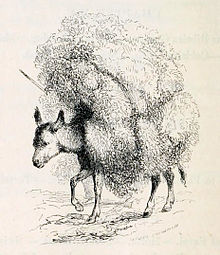 Engraving of a donkey on the island of São Miguel in the Azores, from: Joseph and Henry Bullar, A winter in the Azores; and a summer at the baths of the Furnas, 1841 Engraving of a donkey on the island of São Miguel in the Azores, from: Joseph and Henry Bullar, A winter in the Azores; and a summer at the baths of the Furnas, 1841 | |
| Conservation status | |
|---|---|
| Other names | Burro Anão da Graciosa |
| Country of origin | Portugal |
| Distribution | Graciosa, Azores |
| Traits | |
| Height |
|
| Coat | pale grey or brown, occasionally black or bay |
| Classification | |
| None | (not registered) |
| |

The Burro da Ilha Graciosa or Burro Anão da Graciosa is a breed of small domestic donkey endemic to the island of Graciosa, in the North Atlantic archipelago of the Azores, which are an autonomous region of Portugal. It is critically endangered, but is not officially recognised or reported to the DAD-IS database of the FAO. Efforts are being made to obtain official recognition and protection of the breed.
History
Donkeys were introduced to the Azores, which does not have any large indigenous mammal, by Portuguese colonists in the fifteenth century; their presence there is documented in the Saudades da Terra of Gaspar Frutuoso (1522–1591). The donkey became the principal beast of burden in the Azores. It was used also for riding, but not as a draught animal. Donkeys were very numerous in the islands; in 1841 the number on São Miguel alone was estimated at 8000.
The number of donkeys on Graciosa in now severely reduced; the number remaining was reported as 26 in 2001 and as about 70 in 2008. As with the Miranda donkey, male donkeys used for farm work were for preference castrated; the number of donkey geldings on the island may be a factor in the effective population.
A process of recognition of the Burro da Ilha Graciosa as an autochthonous breed began in 2005. An association, the Associação de Criadores e Amigos do Burro da Ilha Graciosa, was formed in 2013. The University of the Azores oversees a programme of recovery and conservation of the remaining population; it also manages the conservation programme for the endangered Pónei da Terceira.
Characteristics
The Burro da Ilha Graciosa is a small donkey, standing on average 105.8 cm. The coat is usually pale grey or mouse-brown in colour, but may also be bay or black; the belly, muzzle and surround of the eyes are paler. A darker dorsal stripe and shoulder-stripe are often seen, especially in pale-coloured animals; the legs may have zebra-stripes.
References
- Barbara Rischkowsky, Dafydd Pilling (editors) (2007). List of breeds documented in the Global Databank for Animal Genetic Resources, annex to The State of the World's Animal Genetic Resources for Food and Agriculture. Rome: Commission on Genetic Resources for Food and Agriculture, Food and Agriculture Organization of the United Nations. ISBN 9789251057629. Archived 23 June 2020.
- ^ Waltraud Kugler, Hans-Peter Grunenfelder, Elli Broxham (2008). Donkey Breeds in Europe: Inventory, Description, Need for Action, Conservation; Report 2007/2008. St. Gallen, Switzerland: Monitoring Institute for Rare Breeds and Seeds in Europe. Archived 2 September 2009.
- ^ Breed data sheet: Burro da Graciosa / Portugal (Ass). Domestic Animal Diversity Information System of the Food and Agriculture Organization of the United Nations. Accessed August 2024.
- ^ Mónica Bugalho Vieira (2008). O Burro Anão da Graciosa - Parte III (in Portuguese). Bruno F. Bettencourt: RaboTorto, Bloque Tauromáquico, 1 February 2008. Accessed July 2014.
- Mónica Bugalho Vieira (2007). O Burro Anão da Graciosa - Parte I (in Portuguese). Bruno F. Bettencourt: RaboTorto, Bloque Tauromáquico, 16 December 2007. Accessed July 2014.
- Mónica Bugalho Vieira (2007). O Burro Anão da Graciosa - Parte II (in Portuguese). Bruno F. Bettencourt: RaboTorto, Bloque Tauromáquico, 28 December 2007. Accessed July 2014.
- Gaspar Frutuoso (1522–1591), Alvaro Rodrigues de Azevedo (ed.) (1873). As Saudades da terra. Funchal: Typ. funchalense.
- Joseph Bullar, Henry Bullar (1841). A winter in the Azores; and a summer at the baths of the Furnas. London: J. Van Voorst. p. 43.
- (20 June 2013). Burro Anão a caminho do reconhecimento (in Portuguese). Quinta-Feira: Radio Graciosa. Accessed July 2014.
- Valerie Porter, Lawrence Alderson, Stephen J.G. Hall, D. Phillip Sponenberg (2016). Mason's World Encyclopedia of Livestock Breeds and Breeding (sixth edition). Wallingford: CABI. ISBN 9781780647944.
| Donkey breeds of Spain and Portugal | |
|---|---|